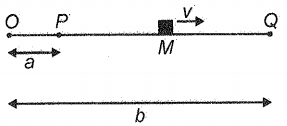A particle performing S.H.M. is at rest at points P and Q which are at a distance a and b from point O. It has velocity v when it is halfway between P and Q. The time period of oscillation is:

1.
2.
3.
4. Data is insufficient to answer.

The time period of a simple pendulum in a stationary lift is T. If the lift moves upwards with an acceleration g, then the new time period will be
1. Infinite
2.
3.
4. 0.707T
Acceleration-time (\(a\text-t\)) graph for a particle performing SHM is shown in the figure. Select the incorrect statement.

| 1. | The displacement of a particle at \(A\) is negative. |
| 2. | The potential energy of the particle at \(C\) is minimum. |
| 3. | The velocity of the particle at \(B\) is positive. |
| 4. | The speed of the particle at \(D\) is decreasing. |
A particle is executing S.H.M. such that its acceleration 'a' is a function of displacement x as . The time period of the oscillation is
1.
2.
3.
4.
A particle of mass 0.5 kg is executing S.H.M. such that its potential energy is 5 J at the mean position. If its total mechanical energy is 9 J and the amplitude of oscillation is 1 cm, then the time period of oscillation of the particle is:
1.
2.
3.
4.
The total mechanical energy of a linear harmonic oscillator is \(600~\text J.\) At the mean position, its potential energy is \(100~\text J.\) The minimum potential energy of the oscillator is:
1. \(50~\text J\)
2. \(500~\text J\)
3. \(0\)
4. \(100~\text J\)
A general graph showing variation in the potential energy \((PE)\) of a particle with time while executing simple harmonic motion is:
| 1. |  |
2. |  |
| 3. |  |
4. |  |
Two simple pendulums of lengths 1.44 m and 1 m start S.H.M. together in the same phase. They will be in the same phase again after
1. 6 vibrations of the longer pendulum
2. 6 vibrations of the smaller pendulum
3. 5 vibrations of the smaller pendulum
4. 4 vibrations of the longer pendulum
A spring has equilibrium elongation 0.1 m when suspended vertically with a load. If the load is slightly displaced vertically downward and released, then the time period of SHM of the system will be approximately
1. 0.1 s
2. 0.4 s
3. 0.6 s
4. 0.3
Select the correct statements regarding potential energy \((U)\) in the simple harmonic motion of a particle along \(x\text-\)axis:
| 1. | \(\frac{dU}{dx}<0\) for all positions of a particle performing SHM. |
| 2. | \(\frac{dU}{dx}>0\) for all time. |
| 3. | Potential energy is minimum at the equilibrium position of a particle performing SHM. |
| 4. | Potential energy increases linearly with the position as the particle moves away from the equilibrium position. |






